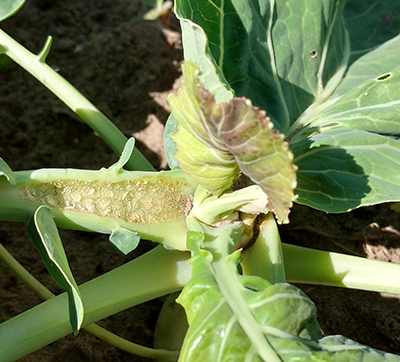East Michigan vegetable regional report – June 15, 2016
Much needed rain and warmer temperatures are coming this week. Harvest and planting is happening simultaneously on some diversified farms.
Weather
Dry conditions are causing poor stands in some areas. Transplants going in without supplemental water are suffering more on bareground sites, but some plasticulture transplants are also feeling the lack of moisture. Much needed rain should be occurring today and tomorrow. It should be a broadly distributed rain dropping approximately 0.25 – 0.5 inches of rain in the southern lower peninsula. Higher temperatures are predicted for the rest of the week.
Here are rainfall (inches since April 1) and degree-day (base 50 degrees Fahrenheit since March 1) accumulations to date from Michigan State University Enviro-weather stations in the region.
Rainfall and degree-day (DD) totals as of June 1 , 2016 | ||||
|---|---|---|---|---|
|
Location |
DD (+ added from last week) |
5-year average |
Rainfall (+ added from last week) |
5-year average |
|
596 (+88) |
606.8 |
6.24 (+0.01) |
6.47 |
|
|
627 (+98) |
618.4 |
2.65 (+0) |
7.62 |
|
|
652 (+104) |
651.9 |
3.45 (+0) |
8.32 |
|
|
625 (+105) |
646.1 |
3.48 (+0.04) |
8.53 |
|
|
656 (+100) |
663.8 |
5.02 (+0) |
9.09 |
|
|
538 (+95) |
581.3 |
4.50 (+0.04) |
9.83 |
|
|
625 (+105) |
641.3 |
4.40 (+0.09) |
7.81 |
|
|
653 (+101) |
643.1 |
4.58 (+0) |
8.71 |
|
|
555 (+83) |
577.2 |
5.81 (+0.03) |
7.90 |
|
Crops
Florence Fennel is bulbing, and will be harvested this week.
Snow peas and snap peas are being continually harvested. Fava beans have been flowering for a couple weeks, but haven’t gotten very tall.
Swede midge damage is evident on organic farms where the pest exists. We are catching them on traps placed at organic farms. Some cabbage and cauliflower has been blinded, and greens are showing brown scarring on the middles of leaf stems.

Cauliflower showing multiple symptoms of swede midge feeding: brown scars, twisted leaf (in the back) and malformed center growing point that will result in a blind plant without a harvestable head.
Some watermelons, melons and summer squash that were under plastic tunnels are now flowering. Cucumber beetles are out as well, so insecticide sprays need to occur in the late evening to protect pollinators of these crops.
Some field tomatoes that were under fabric tunnels are now flowering. I’ve received a couple inquiries about flea beetle damage in tomatoes this year. This pest is not an important pest of these crops, but may make the leaves a little tattered in the early season. The plants will overcome it. I have not seen any bacterial issues in tomatoes yet, which may be one nice thing about the lack of rain so far. If copper isn’t working well for you for bacterial issues, Actigard might be an effective alternative if used preventatively at the lowest labeled rate every 10 days. Mary Hausbeck is doing more trials on this product this summer.
Pickling cucumbers are continually being seeded.
Onions should be about ready for the first of two applications of Movento for thrips control. Thrips have been higher than usual for this time of year because it has been relatively dry. If rain is in the forecast, Movento should be applied with a non-ionic surfactant and with enough time to dry before rain.
Sweet corn is due for a side dressing of nitrogen this week at some farms.
In strawberries, Bernie Zandstra, MSU Weed Specialist, recommends planning a renovation procedure that involves mowing and spraying all vegetation with 2,4-D and a post-emergent grass herbicide, followed by row thinning and a combination of renovation herbicides that address the problem weeds on your farm. Sinbar, Spartan, Prowl H2O and Ultra Blazer are labeled for application at renovation for most annual weeds. Stinger will control many composites, and Poast or Select Max will help control annual and perennial grasses.
Winter squash and pumpkins are being seeded. I helped plant a butternut squash trial this week in no-till, strip-till and heavy residue situations. I thought I would share some lessons learned from that experience. Kill and plow down rye for bare ground or plasticulture fields well before they start flowering to avoid too much biomass. Always be moving forward with the fertilizer shanks in the ground to stop them from plugging with soil. Use screens when measuring granular fertilizer and in the fertilizer hoppers to stop the hoses from plugging. Remove obstructions, such as cotter pins, from the fertilizer tubes to stop them from plugging. Move the fertilizer shank right up behind the coulter to prevent rye from catching and plowing soil.

A) Fertilizer coulter and shank gathering too much residue. B). Residue build up gouges and plows the soil. C) Improper coulter-shank relationship. D) Proper coulter-shank relationship. E). Chunks of urea clogged the tubes. F) Ryan Rowinski of ICL Fertilizers removing tube nipple adapters (which had pins running through them) to remove all obstructions.
Special event
The MSU Weed Tour is being held on June 29, 2016, at the Plant Pathology Field Lab on south campus (3735 N College Road, Lansing MI 48910). It is an all day tour starting at 8:30 a.m. Registration is $25 ahead of time, or $35 on site.
Please contact me at phill406@msu.edu or 616-901-7513 to grab any suspected disease samples from your farm, or send the diseased plant parts to MSU Diagnostic Services.



 Print
Print Email
Email


